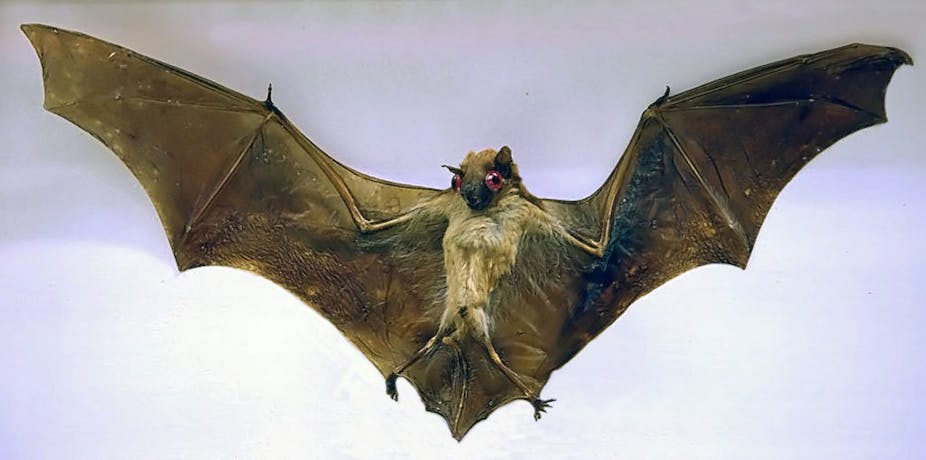As you may have seen, the Daily Telegraph blogger Tim Blair ran a much-tweeted-about poll yesterday asking: “Who is Australia’s craziest left-wing frightbat?”.
Leaving aside the backlash, which was considerable, let’s look at the language he used – and particular the batty bit.
Frightbat? As simply as that a new word is born, delivered kicking and screaming into an ever-evolving linguistic world. Welcome aboard you of great promise, though your chances at long-term survival are probably pretty grim.
It’s clear that this new word of ours is a compound, but its analysis and exact meaning are obscure. From the introduction to Blair’s poll, one gathers it refers to a female member of the left-wing commentariat.

You don’t need to be a linguist, of course, to see the word has two components, “fright” and “bat”. The “bat” bit is what linguists call the compound head, which defines what part of speech the compound belongs to (it’s a noun, because “bat” is a noun).
Semantically, there are two types of head: endocentric heads define the type of thing that the compound refers to (e.g. an overcoat is a type of coat), while exocentric heads are externally related to the type of thing the compound refers to (e.g. “meathead” does not refer to a type of head but rather a person who has a certain kind of head).
“Frightbat” is a metaphorical endocentric compound. It refers to a type of bat, but one which is metaphorically understood to be a female person. Blair is drawing here on a venerable tradition of associating dangerous females with witchcraft and creatures of the night.
The relationship between the “fright” bit and the head is ambiguous.
It modifies it in some way, defining the sort of bat we’re talking about. There are some techniques of analysis going back to Sanskrit (the ancient language of India) for dissecting the relationship between the modifiers and the head. Does this strange bat cause fright, or is it in a state of fright itself?
Consider for contrast the compound “bloodhound”. It’s a type of hound that has an intimate relationship with blood, i.e. with tracking down bleeding animals.
I think Blair probably means that the essence of this bat is the emotion of fright: a “frightbat” inspires a state of fright and panic in others while also being in such a state itself. Its fright is contagious, just as in the purported cases of mass hysteria which women (so the traditional story goes) are particularly vulnerable to.
The delight of creative putdowns
So let’s give some further thought to frightbat’s sociolinguistic function. Invective language and compound neologisms are a partnership that’s been around forever. The plays of the great Athenian comedian Aristophanes (c.446 BC–c.386 BC) are full of abusive neologisms for lawyers, philosophers, and sausage-sellers. Why is this?
Creative putdowns have always delighted us. Their novel semantic content has a puzzle element to it that is fun for listeners to solve, and when well formulated, they indicate the verbal intelligence of the speaker, which in turn intimidates the target of abuse. And they are far more memorable than cliched alternatives.

But their real power is ontological. That is, they deceive us into thinking that the target is so worthy of special treatment that language itself needs a new word to fully depict this new phenomenon. When a neologism hits the mark, it is as though we’ve only now discovered the existence of something previously hidden and finally found the right term for what has been crying out for a definitive label.
Well-coined neologisms therefore have the potential to go viral, as speakers delight in being able to accurately name what they’ve long been trying to find the words for.
Blair is hinting that he has discovered a new species hiding among us, the loathsome, cave-dwelling frightbat. Those sympathetic to his cause can now play the game of frightbat spotting. One of the allures of invective neologisms such as this is that they aid the identification and demarcation of a disliked group, which is (regrettably) an instinctive social activity that humans are very, very good at.
Though the print commentariat often have flamboyant rhetorical personas, those in office or aspiring to office are often more noticeable for the blandness of their discourse. They still clamour after buzzwords that will wrap up an idea or notion in a neat little linguistic package that is memorable.
But for fear of the gaffe, they generally stick to heavily ritualised scripts and tune down any impulse for creative invention.
In contrast with the written word, the spoken word presents the significant challenge of real-time linguistic processing, which is cognitively demanding. Faced with the disastrous costs of miscommunication, politicians often find themselves resorting to cliches and heavily grammaticalised phrases such as “the reality is …” and “in terms of …”
Unlike bats, language doesn’t like to hang around.

